
Ningxia, officially the Ningxia Hui Autonomous Region, is an autonomous region in Northwestern China.
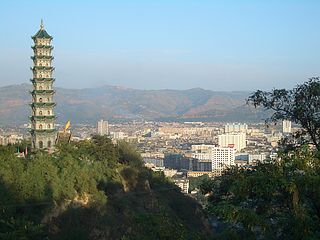
Linxia City, once known as Hezhou, is a county-level city in the province of Gansu, China and the capital of the multi-ethnic Linxia Hui Autonomous Prefecture. It is located in the valley of the Daxia River, 150 km (93 mi) southwest of the provincial capital Lanzhou.

Wuzhong is a prefecture-level city in the Ningxia autonomous region of the People's Republic of China. It was known as Yinnan Prefecture before it was upgraded to a prefecture-level city in 1998. In 2019, Wuzhong had a population of 1.4 million. Wuzhong is located in the Northwest of China, with the Yellow River flowing through the center of the city.
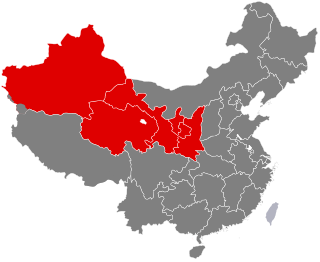
Northwestern China (西北) is a geographical region of China which includes three provinces and two autonomous regions.

Autonomous prefectures are one type of autonomous administrative divisions of China, existing at the prefectural level, with either ethnic minorities forming over 50% of the population or being the historic home of significant minorities. Autonomous prefectures are mostly majority Han Chinese by population. The official name of an autonomous prefecture includes the most significant minority in that region, sometimes two, rarely three. For example, a Kazakh prefecture may be called Kazak Zizhizhou. Like all other prefectural level divisions, autonomous prefectures are divided into county level divisions. There is one exception: Ili Kazak Autonomous Prefecture contains two prefectures of its own. Under the Constitution of the People's Republic of China, autonomous prefectures cannot be abolished.
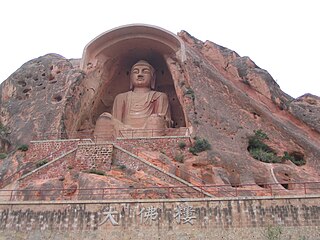
Guyuan, formerly known as Xihaigu, is a prefecture-level city in the Ningxia Hui Autonomous Region of the People's Republic of China. It occupies the southernmost section of the region, bordering Gansu province to the east, south, and due west. This is also the site of Mount Sumeru Grottoes (须弥山), which is among the ten most famous grottoes in China. As of the end of 2018, the total resident population in Guyuan was 1,124,200.

Zhongwei is a prefecture-level city of Ningxia, People's Republic of China. It has an area of 16,986.1 km2 (6,558.4 sq mi) and a population of 1,174,600 in 2019. The city is known for its wolfberry and Gobi watermelon cultivation. One of the world's largest photovoltaic power station, Tengger Desert Solar Park, is located in Zhongwei.

The 1920 Haiyuan earthquake occurred on December 16 in Haiyuan County, Ningxia Province, Republic of China at 19:05:53. It was also called the 1920 Gansu earthquake because Ningxia was a part of Gansu Province when the earthquake occurred. It caused destruction in the Lijunbu-Haiyuan-Ganyanchi area and was assigned the maximum intensity on the Mercalli intensity scale. About 258,707~273,407 died, making it one of the most fatal earthquakes in China, in turn making it one of the worst disasters in China by death toll.
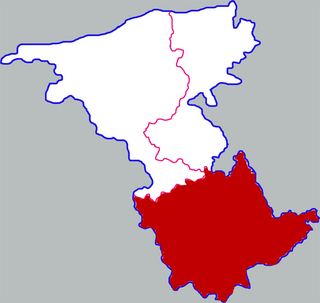
Haiyuan County is a county under the administration of the prefecture-level city of Zhongwei in the southwest of the Ningxia Hui Autonomous Region of China. It is bordered by Gansu to the west. The county has a total area of 6,897 km2 (2,663 sq mi), and a population of approximately 470,000 people as of 2019. It was the site of the 1920 Haiyuan earthquake, which killed at least 200,000 people within and outside of Haiyuan.

Jingyuan County is a county under the administration of the prefecture-level city of Guyuan in the south of the Ningxia Hui Autonomous Region of China, bordering Gansu province to the east, south, and southwest. The southernmost county-level division of Ningxia, it has a total area of 961 km2 (371 sq mi), and a population of approximately 120,000 people.

Pengyang County is a county under the administration of the prefecture-level city of Guyuan in Ningxia Hui Autonomous Region of China, bordering Gansu province to the due north, east, and south. It has a total area of 3,241 km2 (1,251 sq mi), and a population of approximately 250,000 people.
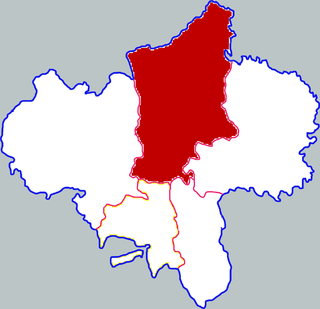
Yuanzhou District, formerly Guyuan, is a district and the seat of the city of Guyuan in the south of Ningxia, China, bordering Gansu province to the northeast. It has a total area of 3,914 square kilometers (1,511 sq mi) and a population of 510,000 people.
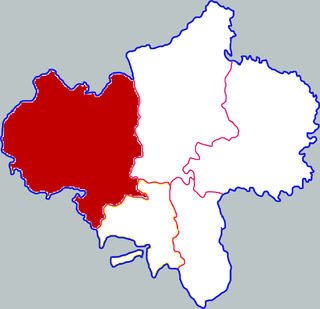
Xiji County is a county under the administration of the prefecture-level city of Guyuan in the southwest of the Ningxia Hui Autonomous Region of China, bordering Gansu province to the west. It has a total area of 3,985 km2 (1,539 sq mi), and a population of 480,800 people, including 263,000 Hui people.

Longde County is a county under the administration of the prefecture-level city of Guyuan in the south of Ningxia Hui Autonomous Region of China.

Lanzhou New Area is a state-level new area established in 2012 and is under the direct control of the municipal government of Lanzhou, Gansu province. It is located in the valley around Lanzhou Zhongchuan Airport, 30 kilometres from the old city of Lanzhou. It is the first state-level new development area in northwestern China, and the fifth state-level new area in the country.

Guyuan Liupanshan Airport is an airport serving Guyuan, a city in Ningxia Hui Autonomous Region, China. It is located in Zhonghe Township, 8.5 kilometres (5.3 mi) from the city center. The airport cost 458 million yuan to build and started operation on 26 June 2010.
Wuzhou, or Wu Prefecture (武州), was a zhou (prefecture) in imperial China. It is in the border area of what is now southern Ningxia and Gansu, China. It was abolished in 958 under Later Zhou.

Hongsibu District is a district within the prefecture-level city of Wuzhong in the autonomous region of Ningxia, China.
Xu Liqun is a former Chinese politician who spent most of his career in northwest China's Ningxia Hui Autonomous Region. He was investigated by China's top anti-graft agency in November 2020. Previously he served as secretary-general of Standing Committee of the People's Congress of Ningxia Hui Autonomous Region.
Minning is a town under the administration of Yongning County, Ningxia, China. As of 2021, it administers Funing Community (福宁社区) and the following six villages:

















